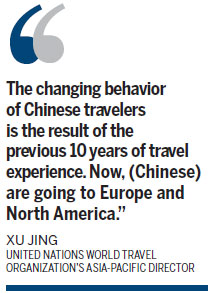Destination desolation
 |
|
Chineseturists visit the Grand Palace in Bangkok in May. [Photo/Agencies] |
"There's a slowing of growth rates to some destinations," he says.
"But if you're talking about sheer volume, it remains large. Southeast Asia is still a big slice of the cake. It's still a very attractive destination. Take the natural beauty with the cultural component of travel Southeast Asia will remain a major destination for Chinese."
Xu believes the relative reduction is more about the outbound Chinese market's maturation and new countries better courting it.
"The changing behavior of Chinese travelers is the result of the previous 10 years of travel experience," he says.
Many took their first international trips in Southeast Asia and now seek something new, Xu says.
And more countries better realize Chinese have been the world's biggest spenders on international tourism in the past five - and especially the past two - years, he says.
"Now, (Chinese) are going to Europe and North America."
Xu points to Maldives as an example of a country that early on devised savvy for courting Chinese.
"Nobody would've guessed Maldives would become (a major) beach tourism destination for Chinese 10 years ago," he says.
"It all depends on how you market to the Chinese. Maldives has made great efforts to effectively penetrate the Chinese market."
Southeastasiatrip.com product manager Peggy Lyu explains: "The impact (on Southeast Asia) can be interpreted as a relative growth of Chinese traveling to other countries. Take South Korea and America, for instance, bringing in more (Chinese currency) to their shops, hotels and restaurants."















